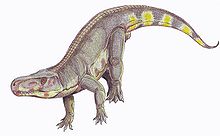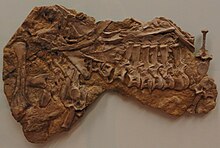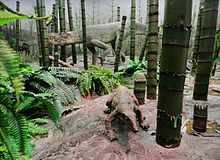Batrachotomus
| Batrachotomus Temporal range: Ladinian, Middle Triassic,
| |
|---|---|

| |
| Reconstructed skeleton, Staatliches Museum für Naturkunde Stuttgart | |
| Scientific classification | |
| Kingdom: | Animalia |
| Phylum: | Chordata |
| Class: | Reptilia |
| Clade: | Loricata |
| Genus: | †Batrachotomus Gower, 1999 |
| Species: | †B. kupferzellensis
|
| Binomial name | |
| †Batrachotomus kupferzellensis Gower, 1999
| |
Batrachotomus /ˌbætrəˈkɒtoʊməs/ is a genus of prehistoric archosaur. Fossils of this animal have been found in southern Germany and dated from the Ladinian stage of the Middle Triassic period, around 242 to 237 million years ago. Batrachotomus was described by palaeontologist David J. Gower 22 years after its discovery.
The locality where Batrachotomus lived was a swampy region and the name comes from the Greek batrachos/βάτραχος (frog) and tome/τομή (cutting, slicing), which refers to its preying on the large amphibian Mastodonsaurus.[1] In contrast with sprawling reptiles, like crocodiles, this large carnivore was very agile with locomotor superiority due to its erect stance. A remarkable feature seen on its back was a row of paired, flattened bony plates. Batrachotomus was possibly an early relative of Postosuchus,[2] which lived during the dawn of the dinosaurs.
Description[]


Batrachotomus was a heavily built, large quadrupedal reptile reaching 6 metres (20 ft) in length. A trait that characterized Batrachotomus, compared to other crurotarsans, was a series of paired small plates on its back which were attached to each vertebra.[3] These bony deposits forming scales are called osteoderms.[3] Flattened and leaf-shaped, these extended from behind the head along the column and reducing in size, ended at the tail.[3] There is also evidence that osteoderms were present on the ventral region of the tail, as seen in Ticinosuchus ferox, and even on the flank, belly and limbs.[3][4]
Like rauisuchians, Batrachotomus walked with an erect posture, although the limbs were not located directly under the trunk. The limbs were not equal in length as the forelimbs were about 70% of the hindlimbs.[3][5] The toe bones (phalanges) are poorly preserved and the only well known bone is a fifth metatarsal (bone in hindlimbs attached to the toe bones) which was hooked in shape.[3] However, hypotheses suggest that probably each forelimb had four toes and each hindlimb five.[6]

Batrachotomus had a tall and narrow skull estimated at 40 to 50 cm (1.3 to 1.6 ft) in length.[7] It had five pairs of fenestrae (skull openings), two pairs of which were for the eyes (called orbits) and the nostrils. Behind the orbits were two temporal fenestrae. These holes probably helped to reduce the weight of the skull and enabled the jaw to open more widely.[8] As a typical archosaur, Batrachotomus had two antorbital fenestrae between the orbits and nostrils, and a fifth pair of small openings at the rear part of the lower jaw.
The jaws contained sharp teeth which were compressed laterally and unequal in size and shape,[7][9] and this variation of tooth shape is known as heterodonty.[7][10] The teeth on the premaxillae (bones at the very tip of the upper jaw) were slender, unlike those of the maxillae (the main tooth-bearing bones in the upper jaw) which had a straight posterior edge.[11] The upper jaw bore 30 teeth, with each premaxilla carrying about 4 teeth and each maxilla 11, while the lower jaw held 22 teeth.[9]
Discovery and history[]

Remains of Batrachotomus have been found in southern Germany, mainly in the Kupferzell fossil locality in northern Baden-Württemberg. Fossil collector discovered the first specimens in a 1977 excavation at the Erfurt Formation, dated from the (late Ladinian) age.[12][13] Other remains attributed to Batrachotomus have been collected in , about 10 km east of Schwäbisch Hall, and in Crailsheim. The most notable are from Vellberg-Eschenau, which are represented by well preserved ribs and vertebrae (MHI 1895), and evidence of forelimbs and hindlimbs (SMNS 90018).[13] Batrachotomus today is displayed in the , Ingelfingen, Stuttgart.
The fossils recovered from a marlstone remained undescribed until 1999 and palaeontologists referred to the genus simply as "rauisuchid" or "Kupferzellia".[7][12] In 1999, palaeontologist David J. Gower described the holotype (SMNS 52970) from the 1977 excavation, which is the largest specimen of the genus,[12][13] comprised by incomplete skull and postcranial material.[1] Anatomy of the braincase (SMNS 80260) was made three years later, shedding light on the evolutionary relationships of the poorly known group of Rauisuchia.[14] In 2009, Gower and reported a detailed reconstruction of the postcranial skeleton for the first time.[15]
Classification[]

Batrachotomus was a prestosuchid, a member of a family of carnivorous archosaurs within the larger group Rauisuchia. The family name "Prestosuchidae" was established in 1966 by American paleontologist Alfred Romer. Prestosuchids were quadrupedal reptiles, medium to large in size, characterized by erect posture, large and narrow skull and large antorbital openings.[16]
Attention was first brought to Batrachotomus in 1993 by , a palaeontologist at Northern Illinois University. Parrish hypothesized that Batrachotomus (then "Kupferzellia") belonged to the family of Rauisuchidae, another clade of carnivorous reptiles, and species of Rauisuchus.[7][17] However, the description of the braincase and a revisited cladistic analysis by Benton and Walker, showing the close relationships between Batrachotomus and Prestosuchus, led to the transfer of Batrachotomus to the family Prestosuchidae.[14][18]
Sterling J. Nesbitt (2011) revised the classification of basal archosaurs, and using the most comprehensive phylogenetic analysis for this group (to date) found Prestosuchidae to be non-monophyletic. The members of this clade were recovered as basal loricatan, of which Batrachotomus was found to be the most derived i.e. most closely related to the clade containing Crocodylomorpha and Rauisuchidae.[19] Subsequent derivatives of this analysis further support this hypothesis.[20][21] In a yet to be formally published revision of Heptasuchus, a medium-sized (~5 m long) "rauisuchian" from the upper of Wyoming, it was recovered as the sister taxon of Batrachotomus using a derivative of Nesbitt (2011) analysis.[22]
The cladogram below follows an analysis by Sterling J. Nesbitt (2011):[23]

| Archosauria |
| ||||||||||||||||||||||||||||||||||||||||||||||||||||||||||||||||||||||||||||||||||||
Paleoecology[]
Since 1977, the rich vertebrate fauna found at Baden-Württemberg reflect a moist region of the Middle Triassic in Germany. Along with Batrachotomus, palaeontologists recovered remains of fishes, amphibians, such as Gerrothorax and Mastodonsaurus, and even animals like nothosaurs and the distinct marine reptile Tanystropheus.[12] Flora of the locality consisted of horsetails, ferns, cycads and conifers, suggesting that there was rich vegetation.[24]
References[]
- Notes
- ^ a b Gower (1999), p. 6.
- ^ Gower (1999), p. 1.
- ^ a b c d e f Gower and Schoch (2009), p. 117.
- ^ Gower and Schoch (2009), p. 104.
- ^ Gower and Schoch (2009), p. 109.
- ^ Gower and Schoch (2009), p. 119 (Figure 8).
- ^ a b c d e Gower (1999), p. 7.
- ^ Benton (2005), p. 112.
- ^ a b Gower (1999), p. 37.
- ^ Gower (1999), p. 38.
- ^ Gower (1999), pp. 37–38.
- ^ a b c d Gower (1999), p. 5.
- ^ a b c Gower and Schoch (2009), p. 121.
- ^ a b Gower (2002), p. 49.
- ^ Gower and Schoch (2009), p. 103.
- ^ Sill (1974), p. 317.
- ^ Parrish (1993), p. 301.
- ^ Benton and Walker (2002), pp. 40–41.
- ^ Nesbitt, S. J. (2011). "The Early Evolution of Archosaurs: Relationships and the Origin of Major Clades". Bulletin of the American Museum of Natural History. 352: 1–292. doi:10.1206/352.1. hdl:2246/6112. S2CID 83493714.
- ^ Li, C.; Wu, X. C.; Zhao, L. J.; Sato, T.; Wang, L. T. (2012). "A new archosaur (Diapsida, Archosauriformes) from the marine Triassic of China". Journal of Vertebrate Paleontology. 32 (5): 1064. doi:10.1080/02724634.2012.694383. S2CID 86797826.
- ^ Sues, H. D.; Schoch, R. R. (2013). "Reassessment of cf. Halticosaurus orbitoangulatus from the Upper Triassic (Norian) of Germany - a pseudosuchian, not a dinosaur". Zoological Journal of the Linnean Society. 168 (4): 859. doi:10.1111/zoj.12038.
- ^ Zawiskie, J.M.; Dawley, R.M.; Nesbitt, S.J. (2011). "The relationships and type locality of Heptasuchus clarki, Chugwater Group (Middle to Upper Triassic), Southeastern Big Horn Mountains, Wyoming, USA". Journal of Vertebrate Paleontology. 31 (Supp. 1): 219. doi:10.1080/02724634.2011.10635174.
- ^ Sterling J. Nesbitt (2011). "The Early Evolution of Archosaurs: Relationships and the Origin of Major Clades". Bulletin of the American Museum of Natural History. 352: 1–292. doi:10.1206/352.1. hdl:2246/6112. S2CID 83493714.
- ^ Rozynek (2008), p. 4.
- Sources
- Benton, Michael J. (2005) [First published 1990]. "The Evolution of Early Amniotes". Vertebrate Palaeontology (Third ed.). Blackwell Publishing. ISBN 0-632-05637-1.
- Benton, Michael J.; Walker, Alick D. (2002). "Erpetosuchus, a crocodile-like basal archosaur from the Late Triassic of Elgin, Scotland". Zoological Journal of the Linnean Society. 136 (1): 25–47. doi:10.1046/j.1096-3642.2002.00024.x.
- Gower, David J. (1999). "The cranial and mandibular osteology of a new rauisuchian archosaur from the Middle Triassic of southern Germany" (PDF). Stuttgarter Beiträge zur Naturkunde B. 280: 1–9.
- Gower, David J. (2002). "Braincase evolution in Suchian Archosaurs (Reptilia: Diapsida): Evidence from the Rauisuchian Batrachotomus kupferzellensis". Zoological Journal of the Linnean Society. 136 (1): 49–76. doi:10.1046/j.1096-3642.2002.00025.x.
- Gower, David J.; Schoch, Rainer R. (2009). "Postcranial Anatomy of the Rauisuchian Archosaur Batrachotomus kupferzellensis". Journal of Vertebrate Paleontology. 29 (1): 103–122. doi:10.1080/02724634.2009.10010365. S2CID 196611289.
- Parrish, J. Michael (1993). "Phylogeny of the Crocodylotarsi, with reference to archosaurian and crurotarsan monophyly". Journal of Vertebrate Paleontology. 13 (3): 287–308. doi:10.1080/02724634.1993.10011511.
- Rozynek, Brigitte (2008). "Schozachia donaea n. gen., n. sp., a new cycad megasporophyll from the Middle Triassic (Ladinian) of Southern Germany". Palaeodiversity. Stuttgart. 1: 1–17.
- Sill, William D. (1974). "The anatomy of Saurosuchus galilei and the relationships of the rauisuchid thecodonts". Bulletin Museum of Comparative Zoology, Harvard. 146: 317–362.
External links[]
- (in English) Batrachotomus at palaeos.com.
- (in German) Der "Lurchenschlächter" Batrachotomus at bestiarium.kryptozoologie.net.
- Middle Triassic reptiles of Europe
- Paracrocodylomorphs
- Middle Triassic pseudosuchians
- Prehistoric pseudosuchian genera
